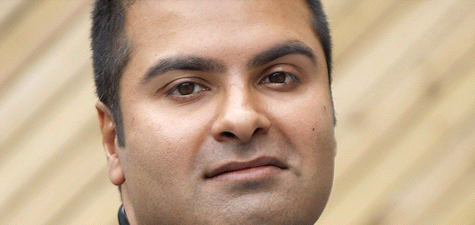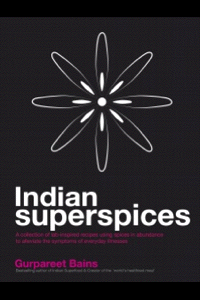
Gurpareet Bains starts his book, Indian Superspices, with an important fact: by weight, spices are the most antioxidant-rich foods. It makes sense that if you eat more antioxidants you’ll probably be healthier and be able to ward off more diseases. The trick is that his Indian dishes can be made with substantial quantities of spices while still tasting good.
How to eat more spices – a lot more spices – is Gurpareet’s theme for this cookbook, which follows his Indian Superfoods (Absolute Press 2011). He starts with the early Indian medical system, Ayurveda, especially the Atharvaveda, “which contains over a hundred formulations for the treatment of diseases, many of which call for spices as a cure.” The introduction goes into detail about the history of Indian medicine and how modern Western medicine is discovering truths in Ayurvedic principals established many thousands of years earlier. Throughout the book, he points to research around the world that proves the importance of spices. Many modern Western medicines already tap into the healing power of spices: Fennel Seeds and Ginger are found in gripe water, Chili is used in rubs that help with aches and pains, Cloves are used in dental emergencies.
What distinguishes Indian Superspices as a cookery book is that each chapter sets out to identify an everyday illness or trouble and then determine the spices that can be used to alleviate it.

It’s winter, albeit mild, in the northern hemisphere, so many people are making chicken soup to help with colds and the flu. “So, don’t forget to take all your ‘medicine’ by wiping your plate clean with a piece of bread.” He lists the Healing Spices along with what they do, for instance, Basil is an antibacterial, anti-inflammatory, antiviral, while Caraway is an analgesic, and Cardamom is many things: antibacterial, anti-inflammatory, antipyretic, and cough suppressant. The recipes list dishes for the Morning, and Day & Night. You could start with Poached Apricots in a Soothing and Cough-Suppressing Syrup followed by very British Detonate My Cold, Baked Beans on Toast. Then for lunch or dinner you could eat Cold-and-Flu-Busting Chicken Madras with Tamarind with garlic, turmeric, fennel seeds, and nigella or Cold-and-Flu-Preventative Saag with Paneer and Cherry Tomatoes followed by Soothe My Sore Throat Ginger Ice Cream. Who wouldn’t feel better after that kind of meal?
Indian Superspices includes chapters on aches and pains, stress, anxiety, and insomnia, and a whole chapter on allergies (eczema, hives, hay fever, asthma, and food allergies). Again he lists spices and their qualities, like curry leaf that is anti-inflammatory and mint that is an antihistamine. You could try Anti-inflammatory Mango and Blueberry Fruit Salad with Antihistamine Tea for breakfast – a tea made with extra nigella seed, mint leaves and honey – and end the day with Spiced Superfruit Cake, with goji berries, nigella seeds, ginger, cinnamon, and mango juice. There is plenty of helpful information in the head notes and in each chapter’s introduction. And if you go overboard, there is even a chapter on diet and detox.
Many people reach for comforting food to feel better. Indian Superspices is a clever, thoughtful book that offers a way to go beyond comfort and use food to really improve our health and heal us.

Nice informative blog content. Thanks for sharing this blog post.